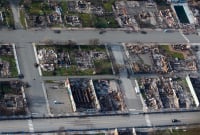Support strong Canadian climate journalism for 2025
I was stymied from getting to work on a rooftop fire protection system this week — by rain. Glorious buckets of it. Visibly welcomed by all members of the plant and animal kingdoms, not least the volunteers that make up our local fire department.
So far, it’s been a relatively subdued fire season across Canada. Let’s emphasize “so far.” The renowned fire expert Mike Flannigan cautions that “July is the month when we usually see the most fire and things could turn around… The fire season will depend on the day-to-day weather and ignitions.”
Nationally speaking, our status is a green-hued Level 2, according to the Canadian Interagency Forest Fire Centre. Firefighters are mostly in their home provinces instead of scrambling across the country to help one another, and the amount of scorched land is below average, so far. Year-to-date, it’s about one-tenth of last year’s horrendous conflagration.
The post-mortems on 2023 are still being published. The latest study finds that last year’s fires “pumped more heat-trapping carbon dioxide into the air than India did by burning fossil fuels.” The researchers figure the fires spewed about 3 billion tonnes of heat-trapping carbon dioxide — four times the carbon emissions of the entire world’s airplane fleet.
If this year does turn out less fiery, that shouldn’t be a surprise. Flannigan told me he anticipates “more fire with climate change as warmer temperatures mean longer fire seasons, more lightning and drier fuels.” But 2023 was so “record-smashing, off the charts” that he expects “even with climate change, years like 2023 will be exceedingly rare.” Let’s hope he’s right — mathematically-speaking it would take just 19 more fire seasons to burn every tree in Canada at that rate.
Nowadays, even a relatively modest month causes havoc. You probably heard the maximum-security prison in Quebec, infamous for holding Canada’s most notorious murderers, had to be evacuated, along with the residents of Port-Cartier. People have been evacuated from the Yukon and Northeastern B.C. to Eastern Quebec and Labrador.
Northern landscapes are getting the full Pyrocene blast elsewhere — for the third time in five years, high-intensity fires are sweeping through the Russian Arctic. These are a "growing monster of climate change," says Guillermo Rein, Professor of Fire Science at Imperial College London.
“A decade ago, Arctic wildfires were considered rare events, hardly ever studied. Now they are happening in all (summers).”
A few weeks ago, over 2,300 people rallied to battle a fire in southwest China’s Yunnan province. Turkey and Greece have been fighting fires in 40-degree temperatures and gale-force winds. Several people have died, hundreds of farm animals and uncountable numbers of wildlife. Nepal has had more than 4,500 fires this year already.
It’s surprisingly complicated to get a clear global picture of what’s going on. As the deniers on social media will happily inform you, the total area burned on Earth may actually be declining. But that’s largely because crop-waste burning in tropical regions gets lumped into the global numbers.
If you focus on the kind of fires we’re worried about — the extreme fires — it’s clear that climate change is driving an exponential increase. A seven-fold increase in the number of extreme fires in the boreal forests of Canada and Europe over the past 20 years. Over 10 times more in temperate conifer forests like the western US and the Mediterranean.
Across the globe, extreme fire is more than twice as frequent, more than twice as intense since 2003. “Those classified as extreme in recent years, released twice the energy of those… at the start of the studied period,” say the authors of new research just published in the journal Nature Ecology & Evolution, which used data from Nasa satellites.
“The fingerprints of climate change are all over this rise,” said Calum Cunningham who led the study. “This is the effect of what we’re doing to the atmosphere, so action is urgent.”
There’s no avoiding the Pyrocene. So, it’s worth knowing how to talk about it in ways that spark that urgency and action.
And we’ve already hit the overarching message — these are “unnatural disasters.” Climate change turns fires into mega-fires.
That’s the “what.” The “why” is fossil fuels. Burning oil, gas and coal accounts for 91 per cent of heat-trapping carbon pollution. But only 11 per cent of news stories about climate change mention fossil fuels, even in passing.
No wonder most people think about recycling when they think about tackling climate change — if you don’t understand the cause of a problem, you won’t aim at it. Use simple language, advises Re.Climate: “fires will keep getting worse until we stop burning fossil fuels.”
And then, the pathway reveals itself: we need to regulate fossil fuel pollution and hold big polluters accountable.
The organization provides a “message triangle” in it’s Wildfires and “Un-natural” Disasters tip sheet, to help us remember the key points proven to drive up public engagement.
You’re going to run into a few forms of pushback. One of the most widespread is that it’s a big, global problem and Canada is a small part of the world population. Our carbon taxes won’t stop the fires. And it’s important to acknowledge that’s true. Which is why the most advanced economies like Canada all need to regulate pollution if there’s any chance of the world acting together.
Every tonne of fossil fuel pollution matters and Canada is a big source of it: one of the Top-10 countries in the world for climate pollution, seventh for per-capita emissions. What’s more, every other G7 country, including the U.S., has been cutting climate pollution while Canada has (maybe) just begun to bend the curve — and even that is only if you don’t count the fossil fuels we export to be burned elsewhere. We have work to do just to catch up to our peers.
You’ll run into more nefarious arguments as well, from the unhinged (Jewish space lasers, secret energy pulse weapons) to the depraved (fires set by the Trudeau Liberals or climate activists as false flag operations).
On the far-right, there’s a growing narrative of “climate authoritarianism,” says Chris Russill, an expert on disinformation at Carleton University. "You see a real blurring of pandemic emergency and climate emergency as overstated, fabricated or false, and used as a pretext to get people to sign on for policies that would extend state control."
The hinge pin for disinformation is arson. And you hear it not only from the putrid corners of the internet, but even from political leaders desperate to keep the public penny from dropping about fossil fuels.
Experts like Russill will tell you that the best debunking is a pre-bunking (immunizing your audience against a falsehood by exposing them to it alongside the evidence to the contrary). Sadly, certain Prairie premiers and Prime Ministerial hopefuls have put us past that point. But you will probably need to do some debunking. And the best approach for that is a “truth sandwich” — instead of repeating the disinformation up front, lead with the truth. Then, describe the disinformation. Seed doubt about its source and fact-check. Then repeat the truth.
Climate change is turning fires into mega-fires. All fires start with some kind of ignition and 93 per cent of the area burned in Canada last year was caused by lightning. Seven per cent by human-ignition. Climate change is turning fires into mega-fires.
Some people have heard about arson so frequently, they may be suspicious of that small number, so it’s worth knowing the nuance between number of fires and area burned: human ignition started 40 per cent of the 6,700 fires in 2023, but they resulted in a vastly smaller area burned than the 59 per cent of fires caused by lightning.
In fact, most human ignition is accidental — ATVs, campfires, cigarette butts — and Mike Flannigan says the number has been decreasing due to education and fire bans.
If the general advice sounds familiar, that’s because the same principles apply to heat waves, super storms and other climate disasters. There are thousands of things you could say, but groups like Re.Climate and Potential Energy have tested them thousands of times on social media and in focus groups to winnow out the ones that give the most “lift.”
“Unnatural disasters” is twice as effective at focusing minds on fossil fuels than calling it “extreme weather,” for example.
And there are a couple other key points that emerge. One is the crucial role of images and video. You might think fires would burn through the lens, but it’s actually difficult to capture human suffering and scale simultaneously. Smoky skylines, blazing mountainsides and lines of evacuating vehicles don’t have the same impact as respiratory distress, homes lost and people helping people in evacuation centres.
Nor are the trusted sources of information quite as straightforward as expected. People trust scientists and doctors. But they’re thinking about people with dirt on their hands and soot on their face. “It’s more like the front line kind of scientist: firefighters,” explained one focus group participant.
The same kind of frontline role holds for the kind “scientists” trusted on fossil fuel replacements as well: “People that are trying to develop things for green energy. I guess those are scientists too,” said another participant representing the general sentiment.






Comments
Monoculture plantations of evergreen trees do not provide for biodiversity which is necessary for a healthy ecosystem. Fire, when it starts from lightning, can go out in a mixed forest with poplars and alders that provide some fire resistance. Evergreens with their saps feed the flames. Clearcutting our forests is a problem. Trees provide water vapour through evapotranspiration. They contribute to clean water in the runoff from rain, hold the soil with their roots, allow for healthy soil in the forest and a source of microorganisms necessary for healthy ecosystems. Corporate greed leads to lobbying governments to approve monoculture plantations for quick regrowth, but in the dry Okanagan, these forests take their time even getting started. Many replantings perish in the dry summer heat and require replanting in subsequent years. Wildfires have roared through these dry areas. Everything is connected. Perturb one part of a system, and you perturb all. Clearcutting and monoculture plantations are powerful factors when considering wildfires. Judy Wyper Peachland Watershed Protection Alliance Peachland BC